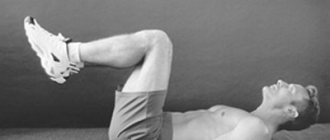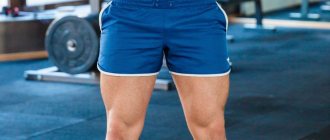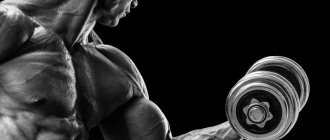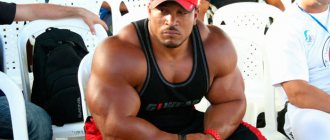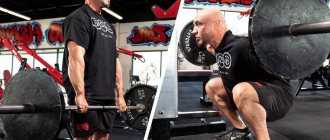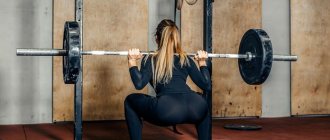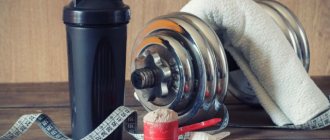For at least the last decade, a number of fairly well-known and authoritative methodologists in the field of “natural” bodybuilding have strongly recommended training one muscle group more often than with a traditional weekly split, that is, more than once a week. Usually it is a recommendation to repeat the load every third or fourth day. The main message to increasing the frequency of training is that each training helps to enhance muscle protein synthesis, namely, it stimulates the formation of NEW protein structures. An increase in the rate of synthesis is observed within two to three days after training, after which it becomes sluggish. That is, when training a muscle group once a week, out of seven days it actively grows only two or three. If, after a drop in the rate of protein synthesis, a repeated load is carried out, then growth will accelerate again (growth of new protein structures) and, thus, the muscle will grow actively almost all week. This promises much faster progress. However, not everyone manages to get good results in practice. If we do not take into account those athletes who have already exhausted their potential for muscle growth (and it is clearly not infinite), then one of the main reasons for the lack of progress with more frequent training is overload. Excessive metabolic stress during training prevents the full stimulus that was provided by training the same muscle group a few days ago. Moreover, frequent high-intensity loads begin to “wear out” the joints.
There may be other explanations for this, but the fact remains: trying to train twice a week intensively (with heavy weights) and in volume causes stagnation, and sometimes regression. However, the author has personally observed in practice on the example of many, both men and women, that loading one muscle group every third or fourth day can significantly accelerate progress in comparison with the classic once-a-week regimen. Therefore, it’s worth trying, but the main thing is to observe only two conditions:
- The load on one muscle group per workout should not be voluminous.
- The load mode should alternate every workout.
Let's look at each of the two points in a little more detail.
Bodybuilding at home
The following bodybuilding program is designed for beginners. It can be used for the following purposes:
- keeping fit for athletes with experience in the gym;
- preparing the body for more intense work (for beginners);
- development of general endurance after a long break from sports.
In addition, this complex is recommended for those men who do not have the opportunity to visit the gym, but can purchase a minimum set of sports equipment and allocate 2-4 hours a week to exercise at home.
For training, you only need a set of dumbbells. Men are recommended to use collapsible equipment with the ability to add weight.
The plan lasts two days. On Monday, the entire upper body and abs are loaded, on Thursday or Friday - the muscles of the chest and arms. This distribution of the load will allow you to effectively work out the body and fully rest between classes.
It is proposed to exercise according to the principle of supersets. That is, two exercises are performed sequentially for one muscle group at once. There is no break between exercises, but rest is allowed between approaches.
On Monday the following plan is recommended:
- crunches on the floor + leg lifts (on parallel bars);
- deadlift + plie squats with dumbbells or kettlebell;
- seated up press + side swings with an inclined body;
- Diamond push-ups + French overhead press
- pull-ups on the horizontal bar behind the head + shrugs.
The second workout of the week consists of the following supersets:
- wide grip push-ups + lying down side raises with dumbbells;
- Bent-over row + lying down pullover;
- bending the arms with emphasis on the knee + bending with alternating changes of arms while standing;
- chest press + Svend press.
Do everything at a pace that is comfortable for you. 3 sets of 10-12 reps are recommended.
The advantage of this program is its versatility. It is suitable for both a beginner athlete and an experienced athlete who wants to keep in shape with minimal time investment. The only difference is the weights used and the number of repetitions.
What does it mean that the load mode should alternate?
This means that one workout should be high intensity (5-6 repetitions), and the other moderate (12-15 repetitions). This is the simplest scheme and there is no need to complicate it, although other options are possible, which we will talk about next time. Such regimes not only stimulate muscle growth, activating various mechanisms of hypertrophy, but also have different effects on the body as a whole, on its endocrine system, joint-ligamentous apparatus (less intensity - less load).
Now let's move on directly to organizing the training process based on the above recommendations.
Home workout for muscle mass
If the previous plan “pumps up” endurance, then the next program is designed to stimulate hypertrophy of muscle fibers. It is not suitable for beginners, as it requires correct execution technique and working with a fairly large weight. However, with minimal weights, this plan can also be used for general maintenance of physical fitness and increasing endurance, for example, after illness or injury.
On the first day, the work of the muscles of the back, shoulder girdle and lower body is emphasized. Procedure for conducting the lesson:
- deadlift;
- forward lunges with dumbbells;
- seated chest press;
- row of one or two dumbbells with a tilted body;
- swings to the sides while standing;
- lying down pullover;
- leg raises while sitting on a bench or crunches on the floor.
The second workout is aimed at developing the pectorals, biceps and triceps:
- bench press;
- push-ups from a bench (hands behind);
- seated biceps curls;
- spreading your arms out to the sides while lying down;
- French overhead press;
- Hammer grip curls;
- biceps curl with emphasis on the knee;
- Svend press.
All exercises are performed 3x10 times. There is no need to rush, you need to focus on the correct execution technique. Weight is selected individually.
The workout begins with a five-minute warm-up. After class, be sure to do a cool-down and stretch the muscles being loaded well. Training to gain muscle mass is ineffective without a special diet.
For the gym (beginner and intermediate level)
The advantage of the following program is a large number of isolated loads. The emphasis is on working on simulators, which makes the program accessible to any level of training.
This plan helps to increase muscle volume and emphasize relief, with the condition of proper nutrition and regular training. The weight of the weight is selected individually, depending on the physical form.
First day:
- hyperextension;
- deadlift with a barbell;
- pulling the upper block behind the head;
- horizontal block pull to the chest;
- standing barbell shrugs;
- swing dumbbells to the sides;
- press up in the simulator;
- wide grip pull-ups.
As you can see, on the first day the main emphasis is on developing the back muscles. During such training, the forearms become noticeably tense.
Second day:
- lifting legs on a bench;
- lying chest press;
- hand movements in the butterfly simulator;
- spreading your arms out to the sides while lying down;
- lifting dumbbells for biceps;
- standing French press;
- bringing your hands together in a crossover;
- lunges with dumbbells;
- platform leg press.
Each workout is quite intense and consists of many exercises. There should be a three-day break between the first and second sessions - this is necessary so that the body has time to recover. All of the listed exercises are performed in three sets of 10 or 15 times, depending on the selected weight.
Is it effective to exercise only a couple of days out of seven?
People involved in sports know that daily visits to the gym and intense exercise only lead to fatigue and joint problems. Also, excessive enthusiasm for sports training leads to a rapid loss of motivation.
To develop muscles, burn fat tissue and form a beautiful body shape, you don’t need to exercise every day. Due to anatomical features, a person’s muscles increase in volume not during exercise, but during rest. Therefore, training without rest for several days is ineffective.
Bodybuilding experts recommend modeling a beautiful body 3 days a week with equal intervals between workouts. But not everyone who wants to join fitness has the opportunity to organize 3 workouts a day.
Be sure to check out:
With its own weight
Not everyone likes to work with a barbell or in machines, so bodyweight training remains popular. The following program will help increase endurance and muscle size, and to perform the exercises you only need a horizontal bar and parallel bars.
Day one – focus on the chest, back and abdominal muscles:
- lifting legs on the horizontal bar;
- wide grip pull-ups;
- pull-ups on parallel bars (legs to chest);
- dips;
- twisting on the floor.
On the second day, the arm muscles are maximally pumped:
- reverse grip pull-ups;
- “diamond” push-ups;
- dips;
- raising legs to chest on uneven bars;
- close grip pull-ups.
All exercises are performed in 3-4 sets of maximum repetitions. The disadvantage of this program is the lack of separate exercises for developing the legs and buttocks. It is recommended to add lunges and squats, 3x15, to each workout.
Recommendations and tips
From the presented training plans, you can choose any one that suits your liking. Those who do not yet see themselves in sports should pay attention to classes in the gym, as they are still more disciplined than home training.
The following tips will help you make your body work more productive.
- Beginners need to follow the same program for at least 8 weeks. This will allow the body to quickly tone up and get used to the load. Beginners can start with home exercises, but the best choice would be to visit the gym, as it is easier to work on machines.
- If the load begins to feel too light, it is recommended to increase the working weight and the number of sets, but not the number of repetitions. This pumps up muscle volume more strongly, while the maximum number of repetitions increases their endurance.
- It is recommended to rest no more than 90 seconds between sets. It is important that the work takes no more than 50-60 minutes. Anything longer in bodybuilding is regarded as a waste of glycogen from the muscles. True, this theory is often criticized, so in general nothing bad will happen if the lesson lasts for an hour and a half, but the feeling of fatigue will be much stronger.
- If you are overweight, it is recommended to add two more cardio sessions to two strength training sessions per week. This could be running, walking on a treadmill, orbitrek or an exercise bike - that is, any type of cardio that you like best.
- Any activity should begin with a warm-up and end with a cool-down - this is an axiom that you will have to come to terms with, otherwise progress will slow down and the risk of injury will increase.
- The main thing that every novice bodybuilder should remember is proper nutrition. Exercise itself will strengthen the body and improve overall endurance, but without the right diet, muscles simply will not grow.
- Between loads, the body must have time to recover, this takes about 72 hours, so it is recommended to exercise on Monday and Thursday. We must not forget about rest - athletes should sleep at least 8 hours a day.
After several months of training 2 times a week, it is recommended to switch to a three-day split - this program is considered perhaps the most convenient and effective.
How many times a week should girls train?
Separately, we note that for girls, daily workouts for weight loss can give the opposite effect to the desired one - especially against the backdrop of a decrease in calorie intake. Instead of speeding up metabolism, the body can increase the level of the stress hormone cortisol, thus provoking fat gain rather than loss.
Losing weight should begin with normalizing your diet, eliminating fast carbohydrates and excessively high-calorie foods. Fat burning workouts are only a way to balance blood sugar levels, and not at all a mechanism for getting rid of excess calories and directly “burning” fat.
Among other things, the phase of the menstrual cycle also plays a role. In the early days, low estrogen levels allow you to burn fat more efficiently - and are ideal for cardio.
Since the total time for muscle recovery is 48 hours for small muscle groups (arms, abs) and 72 hours for large ones (legs, chest), strength training for mass gain is recommended 3-4 times a week. Training for weight loss can be done more frequently (up to 5 times a week), but without a sharp reduction in caloric intake.
- The Truth About Muscle Recovery Time, source
Continuing the topic
- Is it possible to train every day? Daily sports - pros and cons
- How to speed up recovery of muscles (and the whole body) after training?
- Myofascial release (MFR) - massage technique using a roller and balls
The date of last update of the material is October 28, 2020
Next, you should study for 1-2 months according to the “Fulbadi” program (full body - the whole body in one workout). Read more about this program HERE.
A two-day split means that all muscle groups are worked out in 2 workouts. And these 2 workouts can fit into a calendar week of 7 days, or in any other period, preferably not beyond 3-10 days. As a rule, as working weights increase, the frequency of training decreases. You can just stick to the calendar week.
The division of the training program can occur in different ways: top-bottom, bench press-traction, etc. When creating a two-day split, it is advisable to divide the muscle groups into two approximately equal parts, so that about 50% of the muscles are worked out during each workout.
Before performing exercises in each workout, you need to warm up properly! Especially if you are over 30.
Be sure to ask the trainer in the gym to show you the correct technique for doing the exercises and observe from the sidelines. Ideally, take several personal training sessions to develop your technique.
